key CHEVROLET MONTE CARLO 1995 5.G Owners Manual
[x] Cancel search | Manufacturer: CHEVROLET, Model Year: 1995, Model line: MONTE CARLO, Model: CHEVROLET MONTE CARLO 1995 5.GPages: 324, PDF Size: 16.74 MB
Page 33 of 324

Downloaded from www.Manualslib.com manuals search engine Safety Belt Use During Pregnancy
Safety belts work for everyone, including pregnant
women. Like
all occupants, they are more likely to be
seriously injured
if they don’t wear safety belts.
A pregnant woman should wear a lap-shoulder belt, and
the lap portion should be worn as low as possible
throughout the pregnancy. The best
way to protect the
fetus is to protect the
mother. When
a safety belt is worn properly, it’s more
likely that the fetus won’t be hurt in
a crash. For
pregnant women,
as for anyone, the key to making
safety belts effective
is wearing them properly.
Right Front Passenger Position
The right front passenger’s safety belt works the same
way as the driver’s safety belt. See “Driver Position,”
earlier in this section.
When the shoulder belt is pulled
out all the way, it will
lock. If it does,
let it go back all the way and start again.
Center Passenger Position
Lap Belt
If your vehicle has a bench seat, someone can sit in the
center position.
1-23
Page 57 of 324
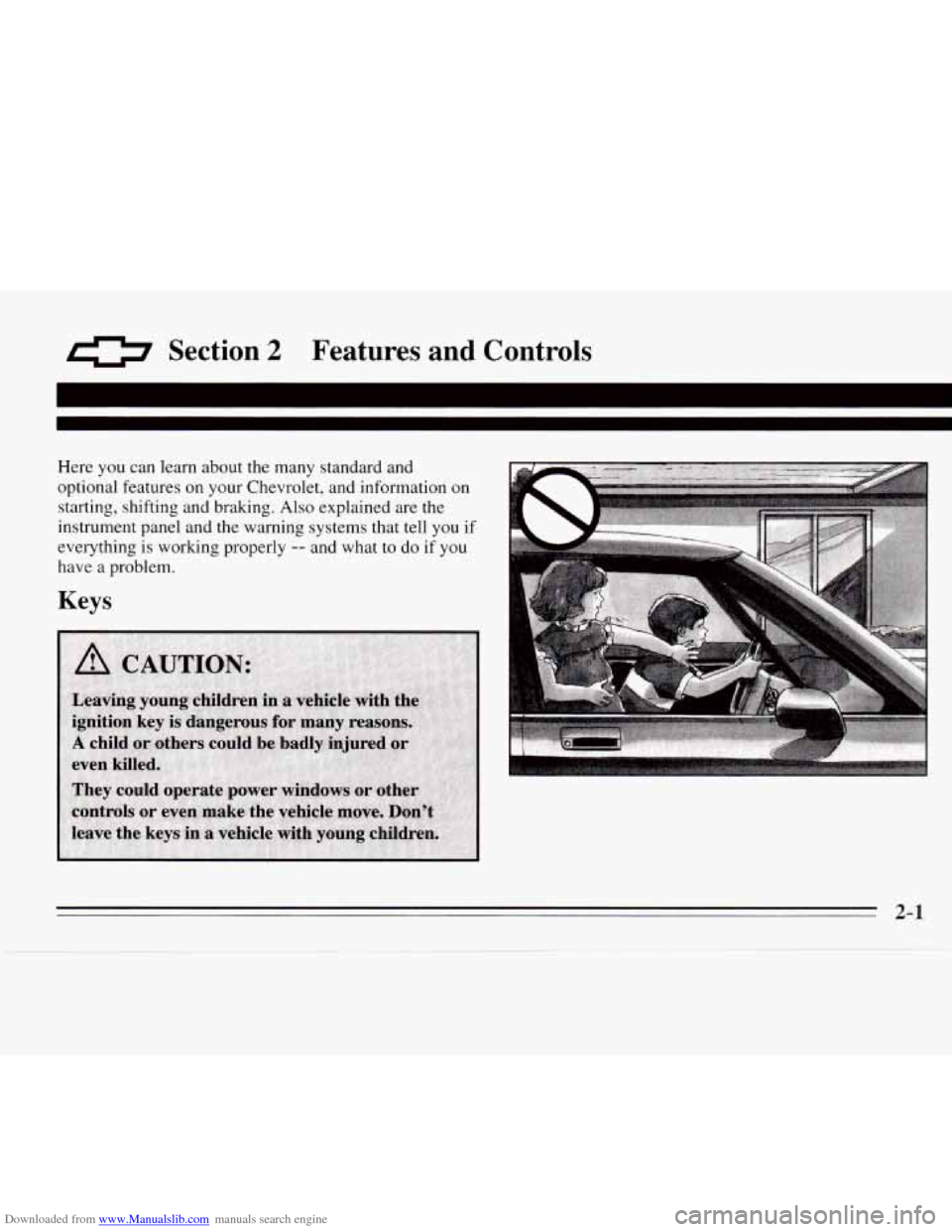
Downloaded from www.Manualslib.com manuals search engine 0 Section 2 Features and Controls
.
Here you can learn about the many standard and
optional features on your Chevrolet, and information
on
starting, shifting and braking. Also explained are the
instrument panel and
the warning systems that tell you if
everything is working properly -- and what to do if you
have
a problem.
Keys
2-1
Page 58 of 324
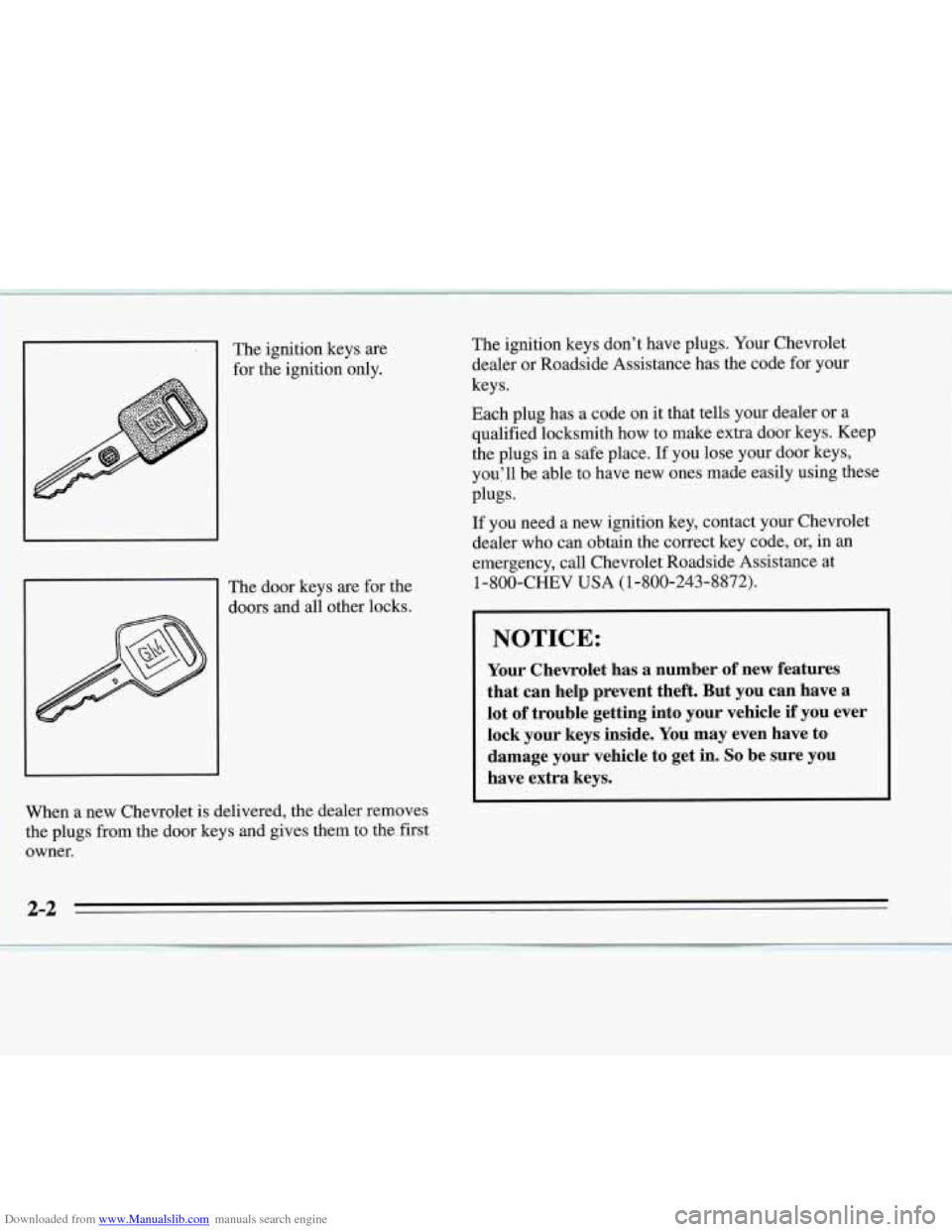
Downloaded from www.Manualslib.com manuals search engine The ignition keys are
for the ignition only.
The door keys are for the
doors and all other locks.
When a new Chevrolet is delivered, the dealer removes
the plugs from the door keys and gives them to the first
owner. The
ignition keys don’t have plugs. Your Chevrolet
dealer
or Roadside Assistance has the code for your
keys.
Each plug has
a code on it that tells your dealer or a
qualified locksmith how to make extra door keys. Keep
the plugs in a safe place.
If you lose your door keys,
youlll be able to have new ones made easily using these
If you need a new ignition key, contact your Chevrolet
dealer who can obtain the correct key code, or, in an
emergency, call Chevrolet Roadside Assistance at
plugs.
1-800-CHEV USA
(1-800-243-8872).
NOTICE:
Your Chevrolet has a number of new features
that can help prevent theft. But you can have a
lot
of trouble getting into your vehicle if you ever
lock your keys inside. You may even have to
damage your vehicle to get
in. So be sure you
have.extra keys.
2-2
Page 59 of 324
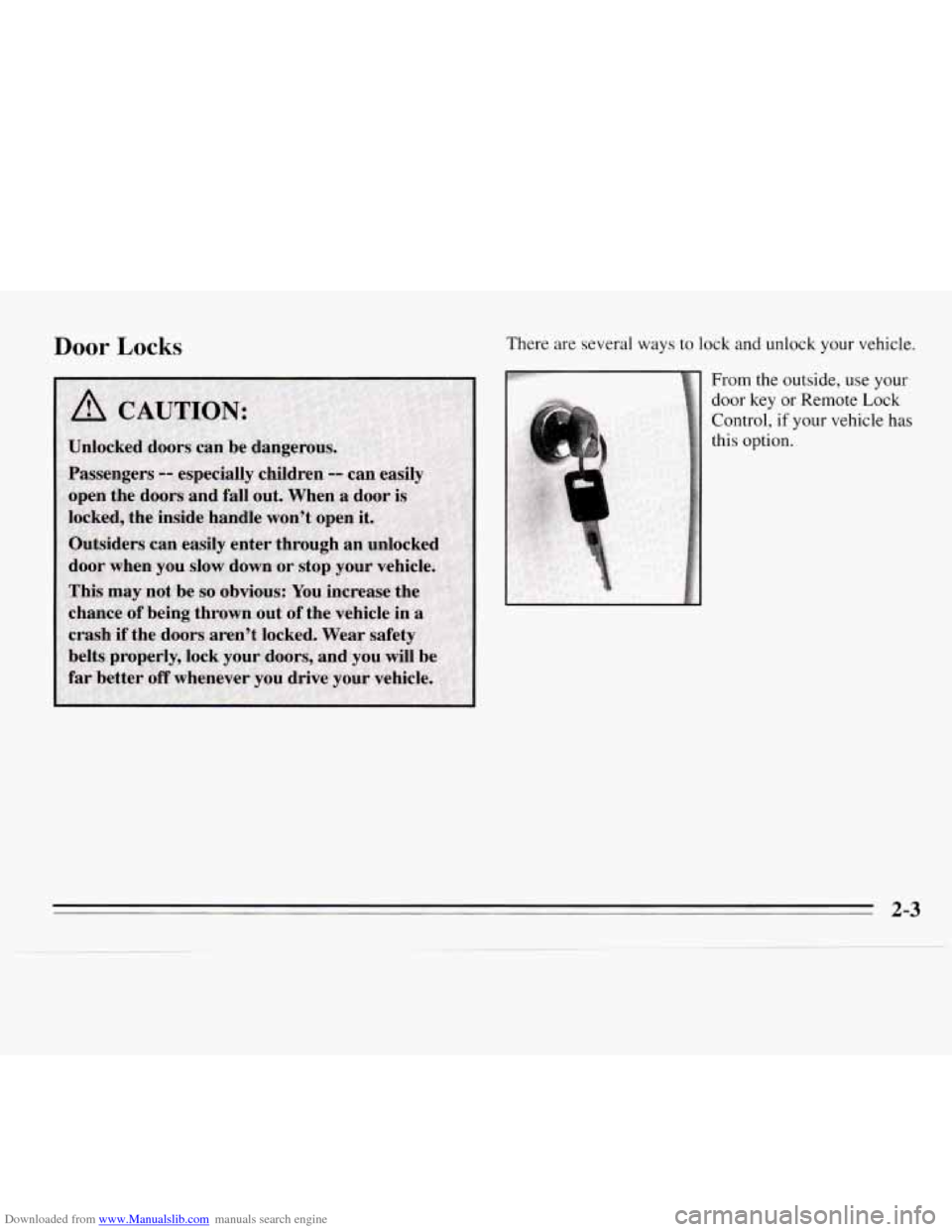
Downloaded from www.Manualslib.com manuals search engine Door Locks There are several ways to lock and unlock your vehicle.
From the outside, use your
door key or Remote Lock
Control,
if your vehicle has
this option.
2-3
Page 60 of 324
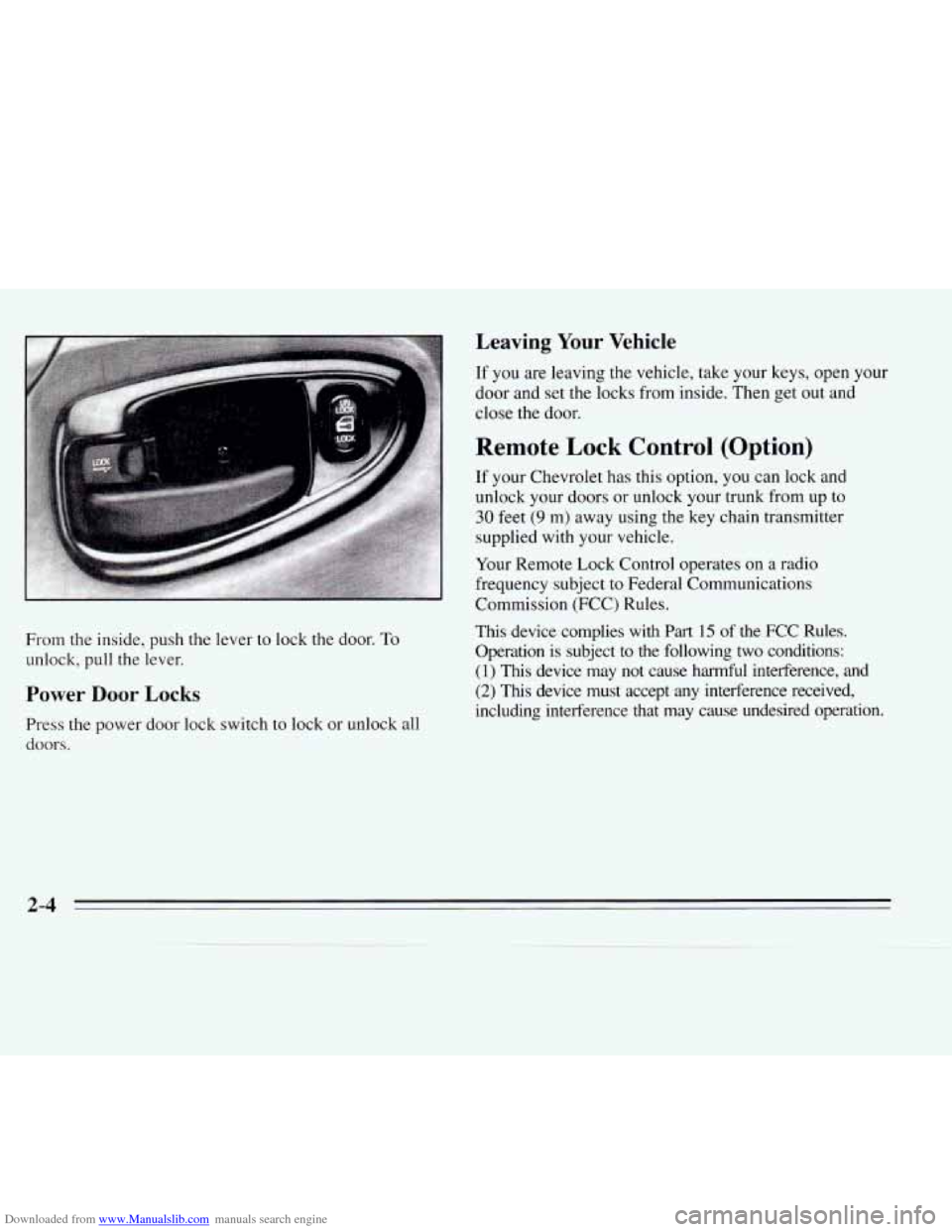
Downloaded from www.Manualslib.com manuals search engine From the inside, push the lever to lock the door. To
unlock, pull the lever.
Power Door Locks
Press the power door lock switch to lock or unlock all
doors.
Leaving Your Vehicle
If you are leaving the vehicle, take your keys, open your
door and set the locks from inside. Then get out and
close the door.
Remote Lock Control (Option)
If your Chevrolet has this option, you can lock and
unlock your doors or unlock your trunk from up to
30 feet (9 m) away using the key chain transmitter
supplied with your vehicle.
Your Remote Lock Control operates on a radio
frequency subject to Federal Communications
Commission (FCC) Rules.
This device complies with Part 15 of the FCC Rules.
Operation is subject to the following two conditions:
(1) This device may not cause harmful interference, and
(2) This device must accept any interference received,
including interference that may cause undesired operation.
2-4
Page 62 of 324
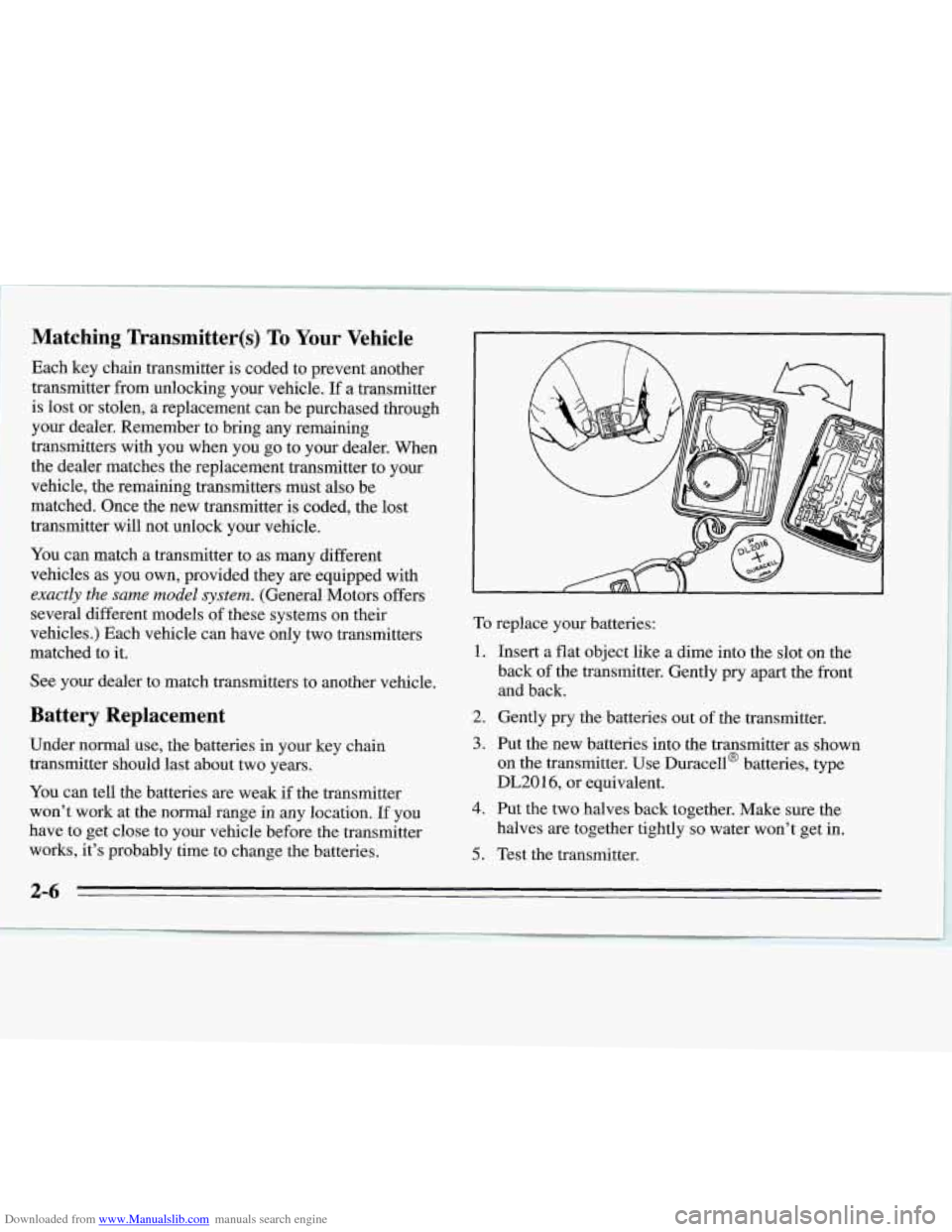
Downloaded from www.Manualslib.com manuals search engine Matching Transmitter(s) To Your Vehicle
Each key chain transmitter is coded to prevent another
transmitter from unlocking your vehicle.
If a transmitter
is lost or stolen, a replacement can be purchased through
your dealer. Remember to bring any remaining
transmitters with you when you go to your dealer. When
the dealer matches the replacement transmitter to your
vehicle, the remaining transmitters must also be
matched. Once the new transmitter
is coded, the lost
transmitter
will not unlock your vehicle.
You can match a transmitter to as many different
vehicles as you own, provided they are equipped with
exactly the same model system. (General Motors offers
several different models of these systems on their
vehicles.) Each vehicle can have only two transmitters
matched to it.
See your dealer to match transmitters to another vehicle.
Battery Replacement
Under normal use, the batteries in your key chain
transmitter should last about two years.
You can tell the batteries are weak if the transmitter
won’t work at the normal range in any location.
If you
have to get close to your vehicle before the transmitter
works, it’s probably time to change the batteries.
To replace your batteries:
1. Insert a flat object like a dime into the slot on the
back
of the transmitter. Gently pry apart the front
and back.
2. Gently
pry the batteries out of the transmitter.
3. Put the new batteries into the transmitter as shown
on the transmitter. Use Duracell@ batteries, type
DL20
16, or equivalent.
4. Put the two halves back together. Make sure the
halves are together tightly
so water won’t get in.
5. Test the transmitter.
2-6
Page 63 of 324

Downloaded from www.Manualslib.com manuals search engine Trunk Lock
To unlock the trunk from
the outside, insert the door
key and turn it.
You can
also
use the Remote Lock
Control, if your vehicle has
Remote Trunk Release (Option)
Press the button under
the instrument panel on
the driver’s side. Your
transaxle shift lever
must
Remember that your trunk can be opened at any time
using this lock release. Be sure to lock your doors.
2-7
Page 64 of 324
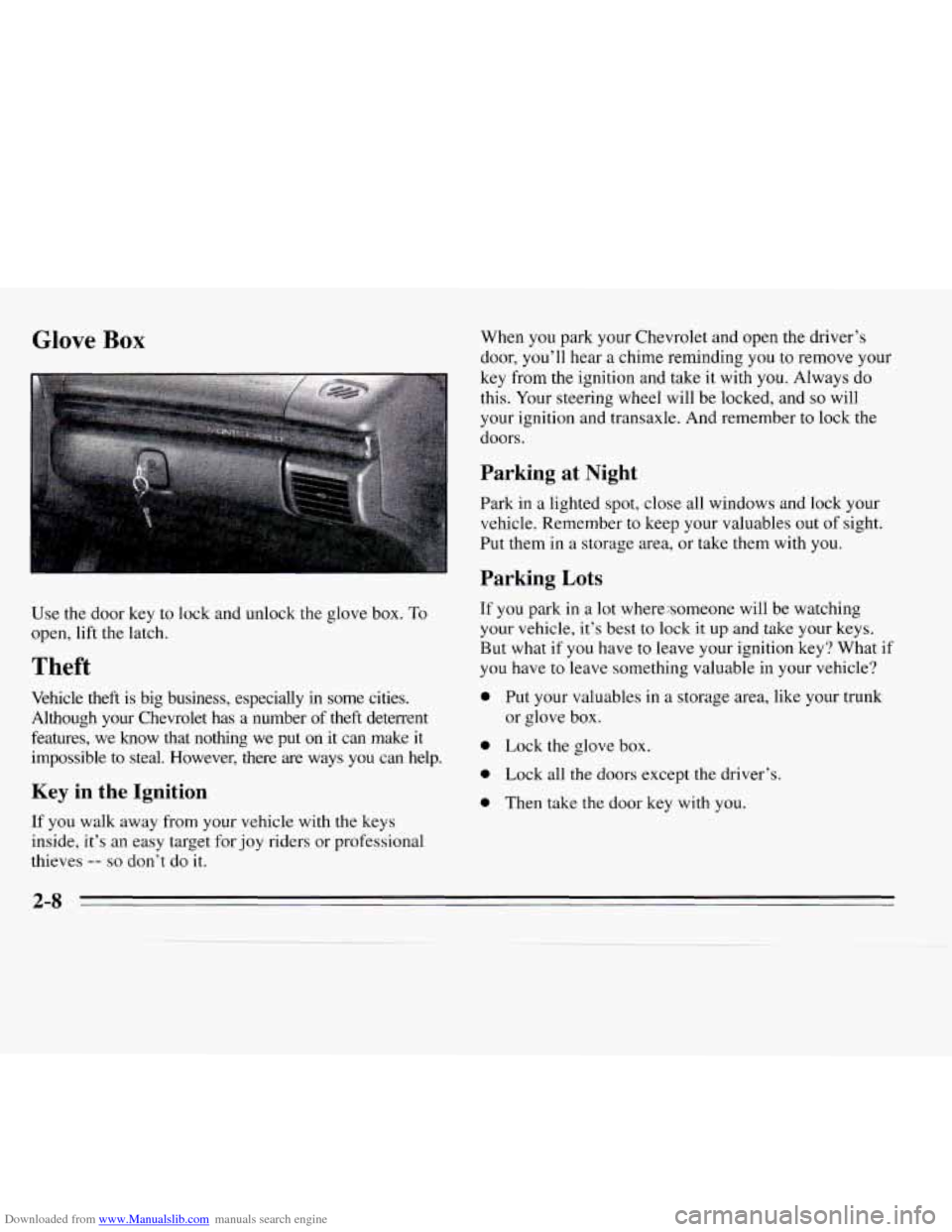
Downloaded from www.Manualslib.com manuals search engine Glove Box
Use the door key to lock and unlock the glove box. To
open, lift the latch.
Theft
Vehicle theft is big business, especially in some cities.
Although your Chevrolet has a number of theft deterrent
features, we know that nothing we put on it
can make it
impossible to steal. However, there are ways you can help.
Key in the Ignition
If you walk away from your vehicle with the keys
inside, it’s
an easy target for joy riders or professional
thieves
-- so don’t do it. When you
park your Chevrolet and open the driver’s
door, you’ll hear a chime reminding you
to remove your
key from the ignition and take it with you. Always do
this. Your steering wheel will be locked, and
so will
your ignition and transaxle. And remember to lock the
doors.
Parking at Night
Park in a lighted spot, close all windows and lock your
vehicle. Remember to keep your valuables out
of sight.
Put them in
a storage area, or take them with you.
Parking Lots
If you park in a lot wheresomeone will be watching
your vehicle, it’s best
to lock it up and take your keys.
But what
if you have to leave your ignition key? What if
you have to leave something valuable in your vehicle?
0 Put your valuables in a storage area, like your trunk
or glove box.
0 Lock the glove box.
0 Lock all the doors except the driver’s.
0 Then take the door key with you.
2-8
Page 65 of 324
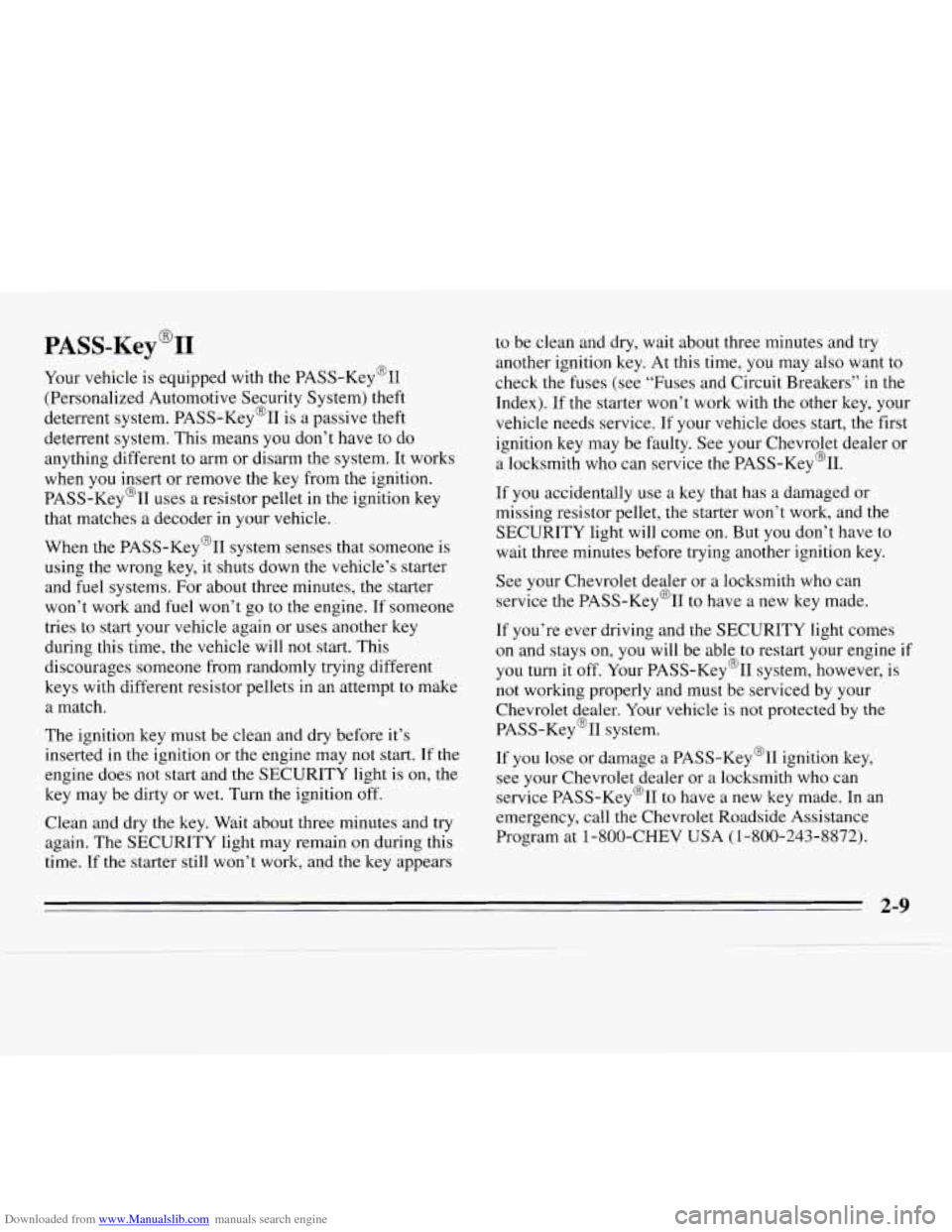
Downloaded from www.Manualslib.com manuals search engine PASS-Key@II
Your vehicle is equipped with the PASS-Key@II
(Personalized Automotive Security System) theft
deterrent system. PASS-Key’II is a passive theft
deterrent system. This means you don’t have to do
anything different to arm or disarm the system. It works
when you insert or remove the key from the ignition.
PASS-Key@II uses a resistor pellet
in the ignition key
that matches a decoder in your vehicle.
When the PASS-Key@II system senses that someone
is
using the wrong key, it shuts down the vehicle’s starter
and fuel systems. For about three minutes, the starter
won’t work and fuel won’t go to the engine. If someone
tries to start your vehicle again or uses another key
during this time, the vehicle will not start. This
discourages someone from randomly trying different
keys with different resistor pellets in an attempt
to make
a match.
The ignition key must be clean and dry before it’s
inserted in the ignition or the engine may not start.
If the
engine does not start and the SECURITY light is on, the
key may be dirty or wet. Turn the ignition off.
Clean and dry the key. Wait about three minutes and try
again. The SECURITY light may remain on during this
time. If the starter still won’t work, and the key appears
to be clean and dry, wait about three minutes and try
another ignition key. At this time,
you may also want to
check the fuses (see “Fuses and Circuit Breakers” in
the
Index). If the starter won’t work with the other key, your
vehicle needs service. If your vehicle does start, the first
ignition key may be faulty. See your Chevrolet dealer or
a locksmith who can service the PASS-Key@II.
If you accidentally use a key that has a damaged or
missing resistor pellet, the starter won’t work, and the
SECURITY light will come on. But
you don’t have to
wait three minutes before trying another ignition key.
See your Chevrolet dealer or a locksmith who can
service the PASS-Key@II to have a new key made.
If you’re ever driving and the SECURITY light comes
on and stays on, you will be able to restart your engine if
you turn it off. Your PASS-Key@II system, however,
is
not working properly and must be serviced by your
Chevrolet dealer. Your vehicle
is not protected by the
PASS-Key@II system.
If you lose or damage a PASS-Key% ignition key,
see your Chevrolet dealer or a locksmith who can
service PASS-Key@II to have a new key made.
In an
emergency, call the Chevrolet Roadside Assistance
Program at
1 -800-CHEV USA (1 -800-243-8872).
2-9
Page 66 of 324
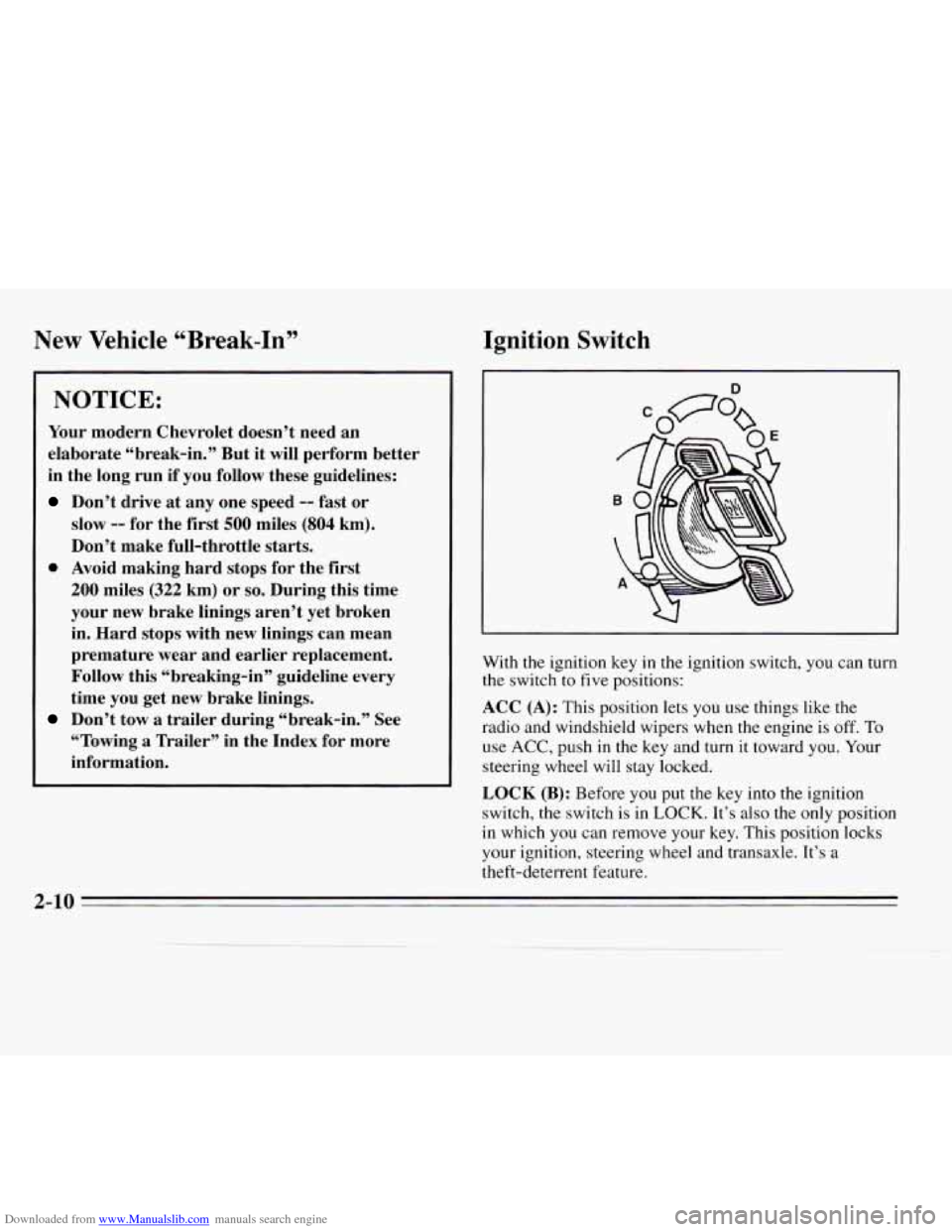
Downloaded from www.Manualslib.com manuals search engine New Vehicle “Break-In” Ignition
Switch
NOTICE:
Your modern Chevrolet doesn’t need an
elaborate “break-in.” But it will perform better
in the long run if you follow these guidelines:
Don’t drive at any one speed -- fast or
slow -- for the first 500 miles (804 km).
Don’t make full-throttle
starts.
200 miles (322 km) or so. During this time
your new brake linings aren’t yet broken
in. Hard stops with new linings can mean
premature wear and earlier replacement.
Follow this “breaking-in” guideline every
time you get new brake linings.
Don’t tow a trailer during “break-in.” See
“Towing
a Trailer” in the Index for more
information.
0 Avoid making hard stops for the first
With the ignition key
in the ignition switch, you can turn
the switch
to five positions:
ACC
(A): This position lets you use things like the
radio and windshield wipers when the engine is off.
To
use ACC, push in the key and turn it toward you. Your
steering wheel will stay locked.
LOCK
(B): Before you put the key into the ignition
switch, the switch is in LOCK.
It’s also the only position
in which you can remove your key. This position locks
your ignition, steering wheel and transaxle. It’s
a
theft-deterrent feature.
2-10